
Buffett famously said that you don’t know who’s swimming naked until the tide goes out. The market has been volatile recently, and the opportunity to invest in high-dividend dividend funds has also attracted market attention. I searched for 10 dividend funds for analysis, and found that the Western Profit State-owned Enterprise Dividend Index Enhanced A (501059) managed by Shengfengyan has performed very well in the past 3 years, with a cumulative return rate of 82.18%. is 3.06%. I think this is also the advantage that some dividend funds can significantly outperform the main broad bases, especially the excellent dividend quantitative index has enhanced the excess returns in recent years. Of course, mining dividend quantitative index enhancement funds requires certain risks and a long-term perspective.
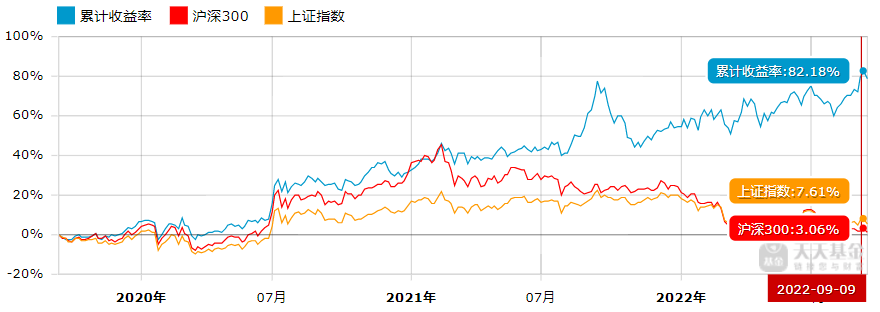
But not all dividend funds can achieve such impressive results, and why can the dividend fund perform so well? Next, I would like to analyze and explore the investment journey of dividend funds from the following questions.
1. What is the investment strategy and risk control of the fund manager of the bonus fund?
2. What is the investment value of the dividend factor (state-owned enterprise dividend) of the dividend fund?
3. What are the fundamentals of the dividend fund and what is the performance attribution?
4. What are the advantages of this bonus fund compared with its peers?
5. What do you think of the 2022 second quarter/interim report of the dividend fund? What highlights did you find?
6. What are the risks that need to be paid attention to when investing in this dividend fund?
1. What is the investment strategy and risk control of the fund manager of the bonus fund?
In the process of selecting a dividend quantitative index-enhanced fund, it is necessary to know that an index-enhancing strategy generally refers to an investment strategy in which fund managers use a combination of “index tracking” and “active management” to obtain excess returns when building an investment portfolio . The excess return will come from “active management”, that is, on the basis of the Beta strategy, relying on the manager’s management ability, while keeping the fund trend in line with the index, the performance of the portfolio can exceed the index or draw back as much as possible. much smaller than the index. Therefore, it is important to choose a good index-enhanced fund manager.

Mr. Sheng Fengyan, majoring in computer application technology from Fudan University, holds a master’s degree. He used to be an equity investment assistant of Everbright Securities Co., Ltd., a researcher of Shanghai Everbright Securities Asset Management Co., Ltd., and a quantitative researcher of Xingzheng Securities Asset Management Co., Ltd. In October 2016, he joined Western Profit Fund Management Co., Ltd. and is currently the Deputy General Manager and Fund Manager of the Public Offering Quantitative Investment Department. Since July 2018, he has been the fund manager of the Western Profit CSI SOE Dividend Index Enhanced Securities Investment Fund (LOF).

Among them, he has been the fund manager of the Western Gain CSI 500 Index Enhanced Securities Investment Fund (LOF) since November 2016, and the fund manager of the Western Gain CSI 300 Index Enhanced Securities Investment Fund since December 2018. Since March 2019, he has served as the fund manager of the Western Profit Quantitative Growth Hybrid Initiated Securities Investment Fund, and since January 2021, he has served as the fund manager of the Western Profit Quantitative Preferred One-Year Holding Period Hybrid Securities Investment Fund. Since 2021 Since June, he has served as the fund manager of the Western Gain CSI Artificial Intelligence Theme Index Enhanced Securities Investment Fund, and since December 2021, he has served as the fund manager of the Western Gain ChiNext Large-cap Exchange Open-end Index Securities Investment Fund Connecting Fund, since 2021. Since December, he has been the fund manager of the Western Profit CES Semiconductor Chip Industry Index Enhanced Securities Investment Fund.
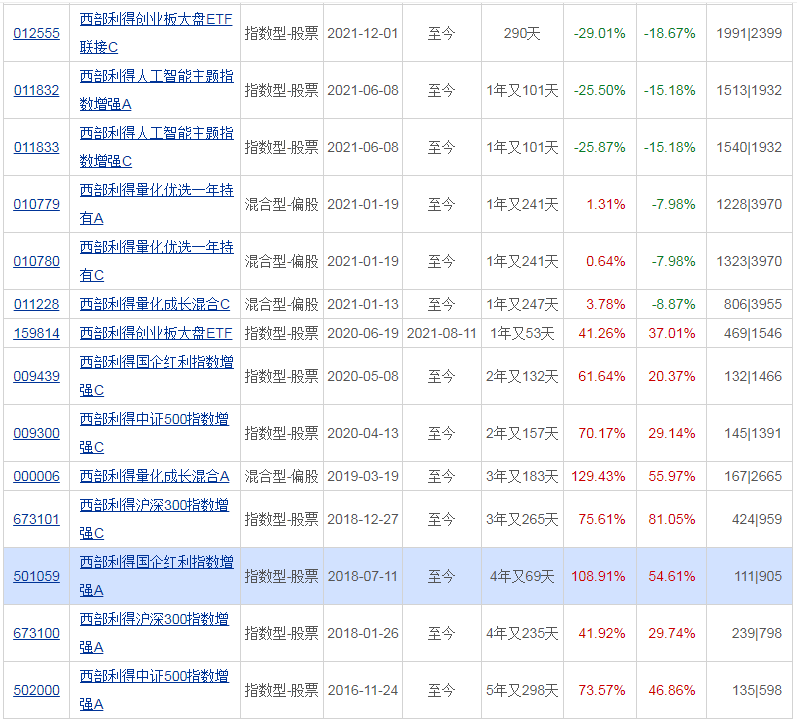
It can be seen that Sheng Fengyan has very rich experience in quantitative investment in index funds. Most of the funds he manages are index-enhanced and quantitative funds, which also paved the way for his investment to obtain excellent excess performance. His investment philosophy is summarized as: good at quantitative index enhancement strategy. Think that weakness and ignorance are not barriers to investing, but arrogance.
In managing the dividend fund, his investment strategy is: using the CSI State-owned Enterprise Dividend Index as the underlying index, on the basis of effectively replicating the underlying index, controlling the tracking error of investment portfolios and performance comparison benchmarks , and combining “bottom-up” The Company actively manages and controls the investment portfolio by means of stock selection , and strives to obtain returns that exceed the performance benchmarks .
At the same time, when the expected constituent stocks are adjusted, the constituent stocks undergo allotment, additional issuance, dividends, etc., and the fund subscription and redemption may have an impact on the tracking effect of the Fund, resulting in the inability to effectively copy and track the underlying index, the fund manager will According to market conditions, reasonable measures can be taken to carry out appropriate processing and adjustment within a reasonable period, so as to strive to control the tracking error within a limited range. However, when the Fund cannot obtain a sufficient number of stocks due to special circumstances (such as insufficient market liquidity, restricted investment in individual constituent stocks, etc.), the Fund Manager will use other reasonable methods (such as buying non-constituent stocks, etc.) substitute. The dividend fund can incorporate stocks other than the underlying index constituent stocks and alternative stocks into the fund’s stock pool and build an active investment portfolio .
Bonus Quantitative Index Enhancement Strategy: The dividend fund is based on the multi-factor model framework widely recognized in the international market, combined with the specific laws of China’s stock market to screen effective factors, and build a multi-factor model after evaluating the factors from multiple angles. Based on factors such as nature, fund size, and factor decay speed, the portfolio is optimized to construct a stock portfolio.
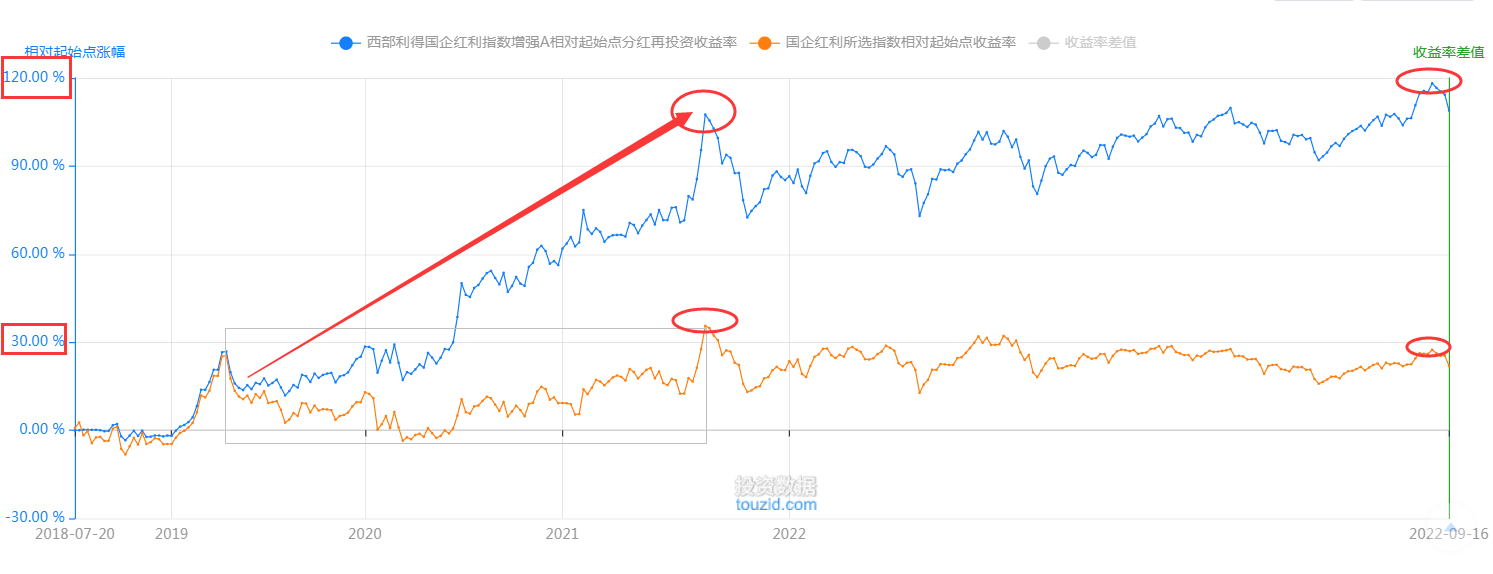
Since the dividend fund was established on July 11, 2018 and managed by Sheng Fengyan, it has significantly outperformed the CSI state-owned enterprise dividend index (abbreviation: state-owned enterprise dividend) in the same period, especially during the bull market from 2019 to 2021. times. As of September 16, 2022, the Western Profit State-owned Enterprise Dividend Index Enhanced A cumulative yield was 108.91%, and the dividend yield of state-owned enterprises was 21.94% in the same period. Among them, from May 17, 2019 to September 10, 2021, the gap between the two gradually widened, and the state-owned enterprise dividend index was in a state of shock and sideways, while the Western Profit State-owned enterprise dividend index increased. A biased towards a volatile upward trend. It also reflects the enhanced excess return capability of the dividend index and the investment strategy advantages of the fund manager Sheng Fengyan.

Since he has been managing the dividend fund, the largest drawdown in the past three years is 19.28%, and the largest drawdown in the past year is 17.59%, which is relatively small compared to peers. %, is relatively stable, which is also related to the relatively scattered and low volatility of his investment positions, which also shows that his performance in Alpha quantitative strategy and risk control is relatively good. At the same time, the fund manager’s maximum profit so far is as high as 214.11%, and the management scale is 7.578 billion. As a fund manager who has managed public funds for nearly 6 years, he is a rare elite among his peers. He has the advantage of seeking progress while maintaining stability and striving to surpass the index. He is also a dividend quantitative index enhancement fund manager that I am more optimistic about.
2. What is the investment value of the dividend factor (state-owned enterprise dividend) of the dividend fund?
To know that investing in dividend funds, choosing the right dividend factor is also very important in the beta strategy. After all, the dividend factor involves a wide range. Usually, we are more familiar with the Shanghai dividend, Shenzhen dividend, and CSI dividend. These three dividend index funds are the most common. There are also different dividend factors such as state-owned enterprise dividends, consumer dividends, S&P A-share dividends, Hang Seng dividends, CSI dividends with low volatility, A-share large-cap dividends with low volatility 50, Shanghai-Hong Kong Shenzhen dividends with low growth, Hong Kong dividends, etc. .
Among them, the Western Profit State-owned Enterprise Dividend Index Enhanced A (501059), which tracks the CSI State-owned Enterprise Dividend Index, directly replicates the trend of the index in the Beta strategy, which has a great correlation. As for the compilation of the index and its performance, I will make a corresponding investment value analysis of the dividends of state-owned enterprises.
2.1 Compilation rules for SOE dividend index: Focus on the investment value of high dividend and high dividend state-owned enterprises.
State-owned Enterprise Dividend Index (full name: CSI State-owned Enterprise Dividend Index) selects 100 securities of listed companies with high cash dividend rate, relatively stable dividend distribution, and certain scale and liquidity from state-owned enterprises in Shanghai and Shenzhen markets as index samples. It reflects the overall performance of the securities of high-dividend listed companies in the state-owned enterprise group. The index was released on July 20, 2012, with a base date of June 30, 2009 and a base point of 1000 points.
Securities of listed companies in the sample space of the CSI All-Inclusive Index that meet the following conditions: (1) Securities of listed companies whose actual controllers are the State-owned Assets Supervision and Administration Commission of the State Council, the Ministry of Finance, local SASACs, local people’s governments, and local state-owned enterprises; Two consecutive years of cash dividends and the annual after-tax cash dividend rate is greater than 0; (3) The average daily total market value in the past year ranks in the top 80%; (4) The average daily transaction value in the past year ranks in the top 80%.
Sample selection method: Rank the securities in the sample space according to the average cash dividend yield of the past two years from high to low, and select the top 100 securities as index samples.
The formula for calculating the index is: Index during the reporting period = Adjusted market value of the sample during the reporting period / Divisor × 1000 Among them, the adjusted market value = ∑(Securities price × Adjusted number of shares × Weighting factor). For the calculation method of the adjusted share capital and the divisor correction method, please refer to the calculation and maintenance rules. The weight factor is between 0 and 1 so that the sample is weighted by the dividend rate .
Regular adjustment: The index sample is adjusted every six months , and the sample adjustment is implemented on the next trading day of the second Friday in June and December each year. In the new round of sample inspection, the original samples that do not meet the following conditions are firstly eliminated in sequence: (1) The attributes of the actual controller have not changed; (2) The after-tax cash dividend rate in the past year is greater than 0.5%; (3) The average daily total market value in the past year ranks in the top 90% of the sample space of the CSI All Index; (4) The average daily transaction value in the past year ranks in the top 90% of the sample space of the CSI All Index. The original sample that meets the above four conditions is still eligible for the new sample space, and the proportion of the sample adjusted each time generally does not exceed 20%, unless the actual controller attributes change or the after-tax cash dividend rate in the past year is greater than 0.5 % and the proportion of the original samples that were firstly eliminated exceeds 20%. The weighting factor is adjusted with the periodic adjustment of the sample, and the adjustment time is the same as the implementation time of the periodic adjustment of the index sample. The weighting factor is generally fixed until the date of the next periodic adjustment.
2.2 The state-owned enterprise dividend index has a wide range of industries, and is biased towards high-dividend industries such as banking, real estate, coal, transportation, etc., as well as relatively dispersed positions in individual stocks, which is a balanced allocation style.
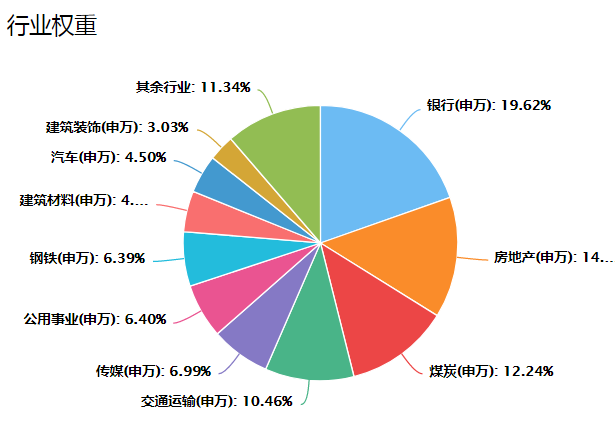
As of September 16, 2022, according to the first-level industries of Shenwan, the index mainly invests in high-dividend industries such as banking, real estate, coal, transportation, media, public utilities, steel, building materials, automobiles, and building decoration. Among them, the banking industry has the largest weight at 19.62%, followed by the real estate weight at 14.22%, the coal weight at 12.24%, and the transportation weight at 10.46%.
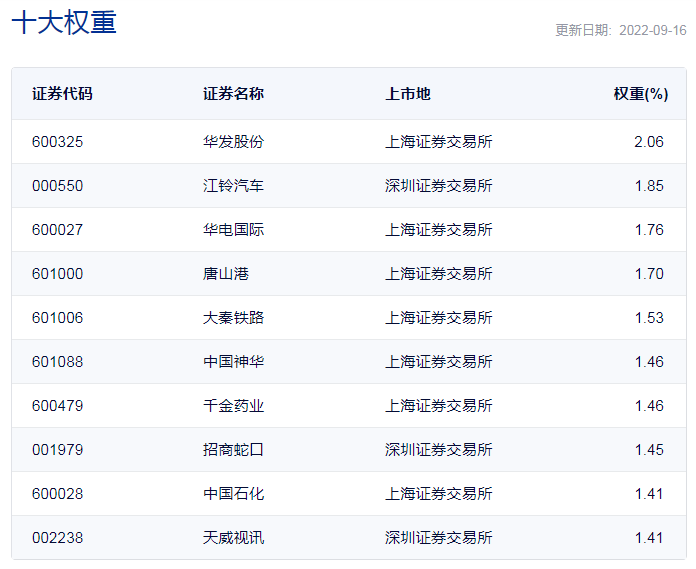
At the same time, the top ten heavyweight stocks of the state-owned enterprise dividend index have a small proportion of positions, which belong to the style of diversified investment and balanced allocation. As shown in the figure above, the index mainly invests in state-owned enterprises such as Huafa, Jiangling Motors, Huadian International, Tangshan Port, Daqin Railway, China Shenhua, Qianjin Pharmaceutical, China Merchants Shekou, Sinopec, and Tianwei Video. than 16.09%.
2.3 Comparing the trend of the state-owned enterprise dividend index and the net value of major broad-based indexes, it outperformed by a large margin, and its performance was relatively excellent.
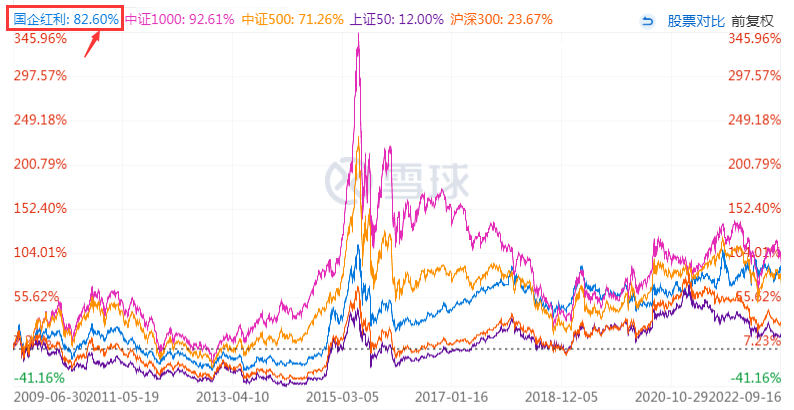
Since the base date of June 30, 2009, the dividend performance of state-owned enterprises has been relatively excellent, with a cumulative yield of 82.6%, significantly outperforming major broad bases. In the same period, the yield of CSI 300 was 23.67%, the yield of SSE 50 was 12%, and the yield of CSI 500 was 12%. The rate of return is 23.67%, second only to the CSI 1000 rate of 92.61%.
2.4 Comparing the trend of the state-owned enterprise dividend index and the net value of the three major dividend indices, it outperformed by a large margin, and its performance was relatively dominant.
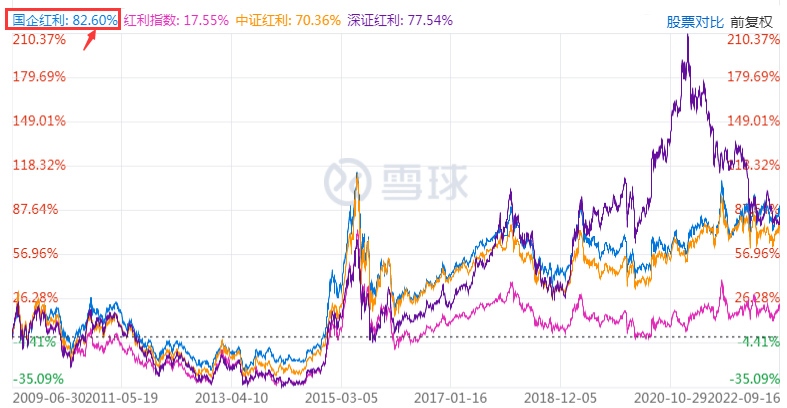
At the same time, since the base date of June 30, 2009, the dividend performance of state-owned enterprises has been relatively dominant, outperforming the dividend index by a large margin. Among them, the cumulative dividend yield of state-owned enterprises is 82.6%, the dividend yield of Shanghai Stock Exchange is 17.55%, the dividend yield of CSI is 70.36%, and the dividend yield of Shenzhen Stock Exchange is 77.54%.
On the whole , the Western Profit State-owned Enterprise Dividend Index Enhancement A has certain advantages in the Beta strategy, and the investment value of the state-owned enterprise dividend index it tracks is outstanding. At the same time, in the index fund investment, the dividend fund also has the color of active management strategy. The combination of the Beta strategy and the excellent Alpha strategy of the fund manager makes the investment potential of the dividend fund even greater.
3. What are the fundamentals of the dividend fund and what is the performance attribution?
At present, there are mainly three types of dividend funds in the A-share market, one is a dividend index fund, one is a dividend quantitative index enhancement fund, and the other is an active equity dividend fund. The fund belongs to the dividend quantitative index enhancement fund. Compared with the pure index, it has the characteristics of active strategy, but it is not all active, and it can also be distinguished from the active equity dividend fund.

Investment objective: This fund is an enhanced stock index fund . On the basis of striving to effectively track the dividend index of CSI state-owned enterprises , it conducts active index portfolio management and risk control through quantitative methods , and strives to achieve investment beyond the target index. Income, and seek long-term appreciation of fund assets.
Investment strategy: The Fund adopts an index replication combined with a relatively enhanced investment strategy, tracks the CSI SOE Dividend Index by means of full sample replication, and conducts relatively enhanced investment management under the premise of strictly controlling deviation and tracking error.
Risk-return characteristics: The Fund is a stock fund, and its expected risk-return level is higher than that of hybrid funds, bond funds and money market funds. The Fund is an index fund, which mainly uses the index replication method to track the performance of the underlying index, and has similar risk-return characteristics to the underlying index and the stock market represented by the underlying index.

As of 2022-06-30, fund institutions with Enhanced A of the Western Profit State-owned Enterprise Dividend Index held 98 million shares, accounting for 68.34% of the total share, and individual investors held 46 million shares, accounting for 31.66% of the total share. From the perspective of the historical holder structure, the proportion of individual investors has decreased, and the proportion of institutional investors has increased, which will help maintain the stability of the fund’s long-term scale.

The fund’s performance score reached 76.75, and the highest yield was 95. It can also be seen that the Alpha strategy ability of the fund manager’s quantitative index enhancement has achieved relatively good results.
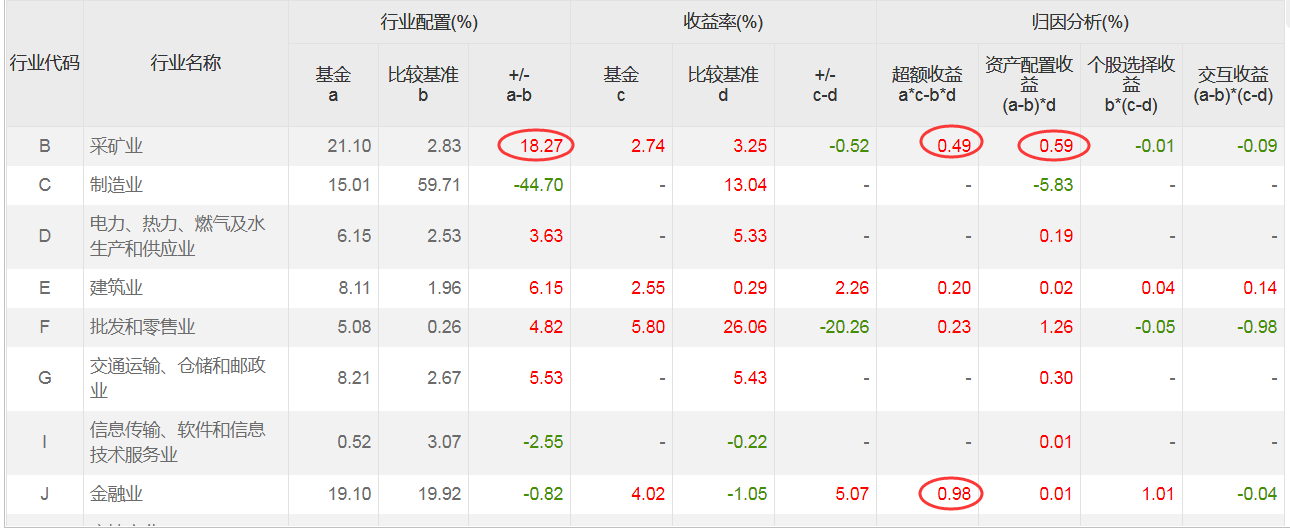
According to Choice data and performance attribution analysis, we can see that the 2022 interim return rate is higher than the benchmark, mainly from the contribution value of the mining industry and the financial industry, and at the same time, the asset allocation income is outstanding.

At the same time, according to the characteristics of the index enhancement fund, the performance attribution of the fund can also be divided into two parts. One part is the contribution value of the state-owned enterprise dividend index itself, which is also called Beta income; the other part is excess income, also called Alpha income. , which can best reflect the active management ability of fund managers, and is also the advantage of the dividend quantitative index enhancement strategy.
4. What are the advantages of this bonus fund compared with its peers?
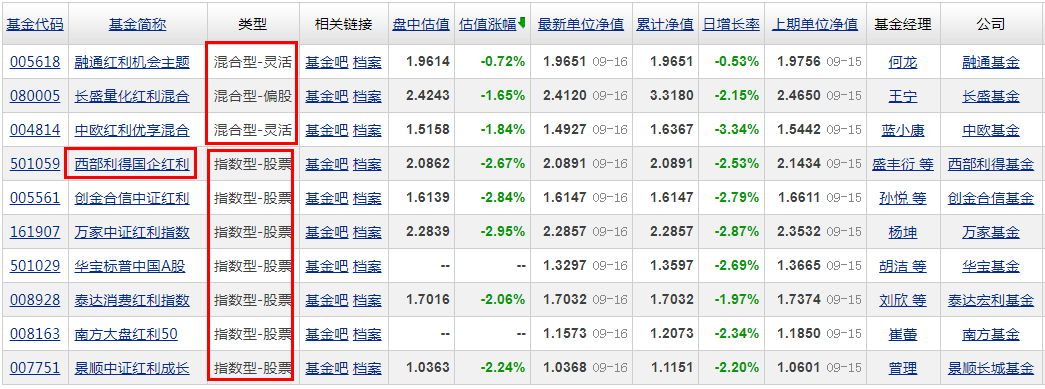
I also selected several dividend-themed funds to compare with this fund, mainly covering three strategic funds: dividend index, dividend quantitative index enhancement, and active equity dividend. I found that among these 10 funds, the Midwest Profit State-owned Enterprise Dividend Index Enhancement A (501059) is the only dividend quantification index enhancement fund. It has performed well in the past three years, with a return rate of 80.89% during the period, second only to Changsheng Quantitative Dividend Mixed (080005) yielded 82.82%, ranking first among 7 index funds, followed by TEDA Consumer Dividend Index A (008928) yielding 78.55%, which belongs to the consumer industry theme in the dividend index. It can be seen that the dividend quantitative index enhancement and active equity dividend strategy are relatively dominant, while the consumption factor in the dividend index Smart Beta strategy is relatively stronger than low volatility, growth and other factors.

From the perspective of stage income: Western Profit State-owned Enterprise Dividend Index Enhancement A has ranked first among the 10 dividend funds in terms of performance this year, and has achieved positive returns in the past 1 month, 3 months, 6 months, 1 year, and 3 years. At the same time, nearly 6 The monthly rate of return is 17.14%, which significantly outperforms its peers, followed by Chuangjin Hexin CSI Dividend Low Volatility Index A (005561) with a rate of 12.51%, which is also positive in the past 1 month, 3 months, 6 months, 1 year and 3 years. Yield, with a yield of 8.27% this year, ranking second among them. (As shown in the figure below: Data as of September 16, 2022, income comparison)

From the comparison of asset allocation : in the second quarter, the Western Profit State-owned Enterprise Dividend Index Enhancement A mainly allocated stock positions, accounting for 91.38% of the net, which belongs to the index funds that hold less stocks, which is helpful for drawdown control. At the same time, it does not hold bonds. Cash accounts for 8.41%, and the top 10 shareholding concentration is 29.73%, which is a balanced allocation style.

From the perspective of industry allocation: the Western Profit State-owned Enterprise Dividend Index has increased A to invest in the extractive industry (accounting for 19.28%), financial industry (accounting for 17.45%), manufacturing (accounting for 13.72%), real estate (accounting for 9.65%), The transportation industry (7.49%), the construction industry (7.41%), the social service industry (5.62%), and a small part of the information technology industry do not own agriculture, forestry, animal husbandry and fishery. The extractive industry has the largest holding ratio among the 10 funds, followed by China Europe Dividend Priority Mix A (004814) and Wanjia CSI Dividend Index (LOF) A (161907).

Comparison of the top ten holdings: As of the second quarter data, the Western Profit State-owned Enterprise Dividend Index Enhanced A Investments in Postal Savings Bank (4.01%), Bank of Jiangsu (3.99%), Industrial Bank (3.55%), Huafa Co., Ltd. (3.18%) and other constituent stocks, the top ten weights total 29.73%, and their positions are relatively scattered. The top three weights belong to high dividend and high dividend stocks of banks.

In general, Western Profit State-owned Enterprise Dividend Index Enhancement A (501059) is an excellent fund in its class. It has performed relatively well among dividend funds this year, especially in the past three years, which has created 80.89% of excess returns. The dividend quantification index Enhanced strategic advantages are prominent, and it is a rare elite among its peers.
5. What do you think of the 2022 second quarter/interim report of the dividend fund? What highlights did you find?
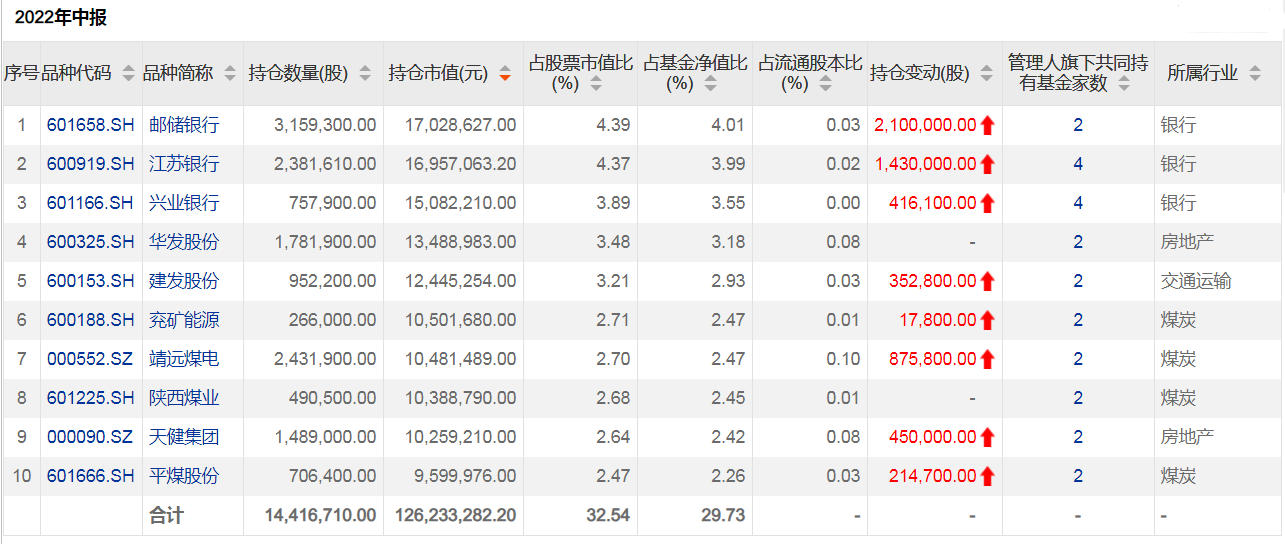
Judging from the data provided by Oriental Fortune Choice, in the 2022 interim report, the Western Profit State-owned Enterprise Dividend Index Enhancement A mainly invests in Postal Savings Bank (accounting for 4.01%), Bank of Jiangsu (accounting for 3.99%), Industrial Bank (accounting for 3.55%) ), Huafa Co., Ltd. (3.18%), C&D Inc. (2.93%), Yankuang Energy, Jingyuan Coal and Electricity, Shaanxi Coal Industry, Tianjian Group, Pingmei Co., Ltd. and other constituent stocks, the top ten weights total 29.73% , Banking and coal occupy the largest proportion in the industry. From the perspective of the subdivision theme concept of heavyweight stocks, they all belong to high-dividend and high-dividend state-owned enterprises, which are in line with the fund’s capture of the dividend strategy opportunities of state-owned enterprises. It can also be seen that the fund manager’s quantitative strategy direction is relatively accurate. At the same time, the allocation of heavyweight stocks such as banks and coal has increased in terms of position changes.

From the comparison of holdings in the first and second quarters, it is found that the dividend index of state-owned enterprises in the west has increased from 15 in the first quarter to 101 in the second quarter. With the growth of the management scale, the allocation of the number of individual stocks has increased significantly. Among them, the post-adjustment of the weight ranking of the coal heavyweight stocks in the previous period and the continuous increase of the positions, the three positions of the Postal Savings Bank, the Bank of Jiangsu, and the Industrial Bank have been upgraded to the top three weights in the second quarter. This is the biggest change. At the same time, most of the new stocks in the second quarter are biased towards high dividends and high dividends such as coal, banks, real estate, and construction.

From the comparison of industry allocation in the first and second quarters, it can be seen that among the first-tier industries, the focus on increasing the industrial weight accounted for the largest proportion in the second quarter, and the amount of positions doubled, becoming the largest weight. However, the weight of finance and energy decreased but the amount of positions increased, the weight of raw materials remained unchanged but the amount of positions increased, and the weight of information technology decreased but the amount of positions increased. At the same time, five new industries were added: real estate, discretionary consumption, public utilities, major consumption, and healthcare. According to the current market trend, real estate, discretionary consumption, major consumption, medical and health care are all undervalued positions. I think the fund manager may be looking for individual stock opportunities in these areas, which is also a major highlight of investment.
6. What are the risks that need to be paid attention to when investing in this dividend fund?
Based on my personal investment and tracking observation of quantitative index enhancement funds, I found that not every time period Alpha strategy is effective, and it will also be greatly affected by Beta strategy in many cases. Since the fund is tracking the dividend index of state-owned enterprises in the Beta strategy, in the long-term investment process, it is necessary to understand the changes in the valuation of dividends of state-owned enterprises and the life cycle of dividend companies, and do a good job of reasonable position management. The long-term planning of the allocation, do not blindly overweight or fill the position to chase the ups and downs. The quantitative index enhancement strategy should be viewed rationally, and should not be “deified”.
Although when we choose the dividend index enhancement fund, we all hope to obtain the excess return that the fund manager’s Alpha strategy creates beyond the index return. However, one thing to know is whether the fund manager can create excess returns in a long-term, stable and effective manner in the active management strategy. This is also a risk that needs to be paid attention to in the process of investing in quantitative index enhancement funds.
At the same time, Sheng Fengyan has excellent quantitative index enhanced investment experience and excellent performance. Most of the funds he manages are index enhanced and quantitative funds. I think professional managers will be better than ordinary people. In choosing the Western Profit State-owned Enterprise Dividend Index Enhanced A (501059) investment, adhere to the Buffett-style principle and use the stupidity of the market to make regular investments, which can avoid many emotional influences, achieve the unity of knowledge and action, and the effect of investment experience is more stable.
Risk warning: The fund has risks, and investment should be cautious. The above are only personal opinions and do not constitute investment advice.
Originality is not easy, remember to like it.
#Snowball Public Raising Talent Program# #Golfers Planting Season# # Lao Siji Hard Core Evaluation#
@Today’s topic @雪ball creator center @ETF star push officer @ golf friend welfare @ snow ball fund @west profit fund @shengfengyan @west profit China Securities 500
$ Western Profit State-owned Enterprise Dividend Index Enhancement A(F501059)$ $ Western Profit State-owned Enterprise Dividend Index Enhancement C(F009439)$
$Postal Savings Bank (SH601658)$
This topic has 11 discussions in Snowball, click to view.
Snowball is an investor’s social network, and smart investors are here.
Click to download Snowball mobile client http://xueqiu.com/xz ]]>
This article is reproduced from: http://xueqiu.com/2154442048/230981037
This site is for inclusion only, and the copyright belongs to the original author.